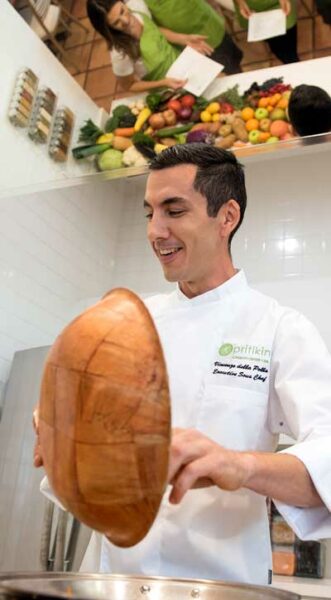How to Become a Vegetarian

How to Become a Vegetarian in 4 Simple Steps
-
Step 1. Find a plant-based alternative
How to get started? Make a swap! Pick one animal-based product that you would like to swap out of your daily life. For example, it might be beef, cow’s milk or eggs. Now, find a plant-based alternative for it at the store. Below is a list of common plant-based alternatives for common animal-based food items.
Best vegetarian foods: a beginner’s shopping list
Here are some nutritious and versatile vegetarian foods to stock up on if you want to become a vegetarian or simply are trying to eat more plant-based foods:
- beans (black, white, kidney)
- chickpeas
- lentils
- extra-firm tofu
- nutritional yeast
- leafy greens
- vegetables
Next, substitute in the vegetarian option in your food whenever you would have previously reached for the animal product. For example, if you choose to remove cow’s milk from your dietary repertoire, you might pick up almond milk instead at the store and splash it into your coffee to complete your first vegetarian swap. Way to go! You are one step farther on your quest to become a vegetarian. (Tip: for the healthiest swap and a taste similar to milk, choose an unflavoured and unsweetened plant-based alternative.)
Before you skip with excitment over to the market to pick up your vegetarian options, remember this: a vegetarian options doesn’t automatically make it a good choice. For example, coconut ice cream is still ice cream – it contains saturated fats and sugars are not healthy choices for those with heart health concerns or diabetic. However, there are less obvious examples such as avocados, nuts and seeds. All of these are considered healthy whole foods yet, they are high in calories and could curb your weight loss efforts.
Common plant-based alternatives for animal-based food products:
- Replace Beef chili with a soup made from White Beans, Kidney Beans, and/or Chickpeas
- Replace Butter with Apple Sauce (apple sauce can be used in substitution for butter in some baking recipes.)
- Replace Chicken with Firm Tofu
- Replace Cow’s Milk with Soy Milk
Replace Egg with Banana or Ground Flax Seed (Combine 3 tbsp water with 1 tbsp of ground flax seed in a container. Mix and let sit until it becomes thick. Add to recipe in place of an egg. In some cases, a mashed banana can work in place of an egg.)
- Replace Ground Beef with a mixture of Crushed Walnuts and Cauliflower
Step 2. Learn how to cook vegan

Most plant-based alternatives can easily take the place of an animal-based food in your favorite recipes. An easy place to start is with tofu. Extra firm tofu may be the easiest vegetarian alternative to replace meat because it requires little prep work, slices with a consistency of meat and takes on any flavour you add to it. Firm tofu can be added to a smoothie to create a creamy texture. For scrambled eggs, silken tofu mashed with a potato masher and browned in a pan is surprisingly fantastic.You may be surprised how good a vegetarian chili tastes with beans as the main protein source instead of meat. Swap ground beef for a blend of ground walnuts and cauliflower when you make the meaty part of your tacos or plate of loaded nachos. For your Bolognese sauce, try lentils – they work great!
What about snacks? Swap that salty beef jerky for kale chips sprinkled with nutritional yeast. (If you just cringed, don’t knock it till you’ve tried it – you may be pleasantly surprised by vegetarian alternatives).
Step 3. Eat to be a healthy vegetarian
Although fresh vegetables are some of the most nutrient-dense foods on the planet being a healthy vegetarian does require some attention to certain nutrients to avoid deficiencies. Here are nutrients most commonly low in a vegetarian diet, along with where you can find them. Choose foods rich in these nutrients regularly to ensure you’ve got a healthy, balanced diet.
Vitamin B12
Vitamin B12 is essential to the human body. Without sufficient vitamin B12 your body will struggle to make energy. Since it is abundantly found in animal products, vegetarians need to seek out alternative sources of this vital nutrient. Nutritional yeast is a good source of vitamin B12 for vegetarians. Nutritional yeast is a yellow-coloured, flaky powder with a cheesy taste. It hides nicely into salad dressings, sauces or even on top of popcorn. Yum!
Iron
Vegetarians get iron from legumes (lentils, soybeans, tofu), whole grains (oatmeal, quinoa), vegetables (swiss chard, collard greens), nuts and seeds. However, iron is less readily absorbed from plant-based foods than animal-based. To improve your ability to absorb iron from plant-based foods combine them with vitamin C containing foods (bell peppers, tomatoes, citrus, berries, tomatoes). Better together – when both iron and vitamin C are present it enhances absorption in your gut.
Zinc
Zinc can be found in legumes, beans and whole grains. However, these foods also contain phytic acid that can hinder the absorption of zinc by the body. Soaking beans and grains before cooking them can reduce the phytic acid.
Omega 3 fatty acids
Omega3 fatty acids are a group of fats that are essential to your body’s health. A large and growing body of literature has suggested that omega 3 fatty acids may be protective against cardiovascular disease. Usually when one thinks of omega 3 fats it is marine sources, such as fish, that come to mind. So, how does a vegetarian get omega 3? There are some plant-based sources including walnuts, seeds, seaweed and other dark leafy greens contain omega 3 fats. Of note, whether plant sources or marine sources of omega 3 fatty acids impart similar benefits is still controversial.
Vitamin D
When your skin is exposed to the sunlight you can make vitamin D. Otherwise, as a vegetarian your only other source of vitamin D may be mushrooms. Cow’s milk is fortified in efforts to boost public consumption of vitamin D. Despite fortification efforts, most people are still not getting enough vitamin D. With growing interest in this nutrient and its potential health benefits expect to hear more about it in the future.
Step 4. Repeat
You did it! Congratulate yourself (maybe do a little celebratory dance). Once you have successfully swapped a plant-based alternative for an animal-based food, start back at step 1 again. Try substituting another one.
The journey to becoming a vegan can be fun. Sure, becoming a vegetarian will take some work at first. But, tackling your change in food choices one at a time will have you eating more plants in no time. Making small changes in your life are not only more manageable, being successful at each increment means more celebrating along the way. This is not only a plan for success on how to become a vegetarian but for almost all healthy lifestyle changes.
If you’re still feeling a bit lost, there’s ways to get expert help with how to become a vegetarian and do it in a healthy way! From hands-on culinary classes to expert nutritionist and physicians, there are so many friendly and supportive people at the Pritikin Center who are ready to help you reach your vegetarian goals.
Sources
- Vitamin D deficiency as a public health issue. Proc Nutr Soc 2017 Aug;76(3):392-399.
- Health effects of vegan diets. Am J Clin Nutr 2009 May;89(5):1627S-1633S
- Omega-3 Treatment Trialists’ Collaboration. Associations of omega-3 fatty acid supplement use with cardiovascular disease risks: Meta-analysis of 10 trials involving 77 917 individuals. JAMA Cardiol 2018;3:225-34.